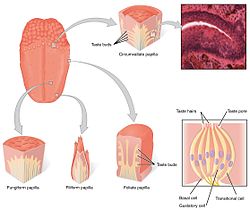Taste bud
This article needs additional citations for verification. (December 2020) |
| Taste buds | |
|---|---|
 Taste buds are small structures present within the papillae of the tongue | |
| Details | |
| System | Taste |
| Identifiers | |
| Latin | caliculus gustatererius |
| MeSH | D013650 |
| NeuroLex ID | birnlex_4101 |
| TA98 | A15.4.00.002 |
| TA2 | 7037 |
| TH | H3.04.01.0.02116, H3.04.01.0.03013 |
| FMA | 54825 |
| Anatomical terms of microanatomy | |
Taste buds are clusters of taste receptor cells, which are also known as gustatory cells.
On average, the human tongue has 2,000–8,000 taste buds.[2] The average lifespan of these is estimated to be 10 days.[3]
Types of papillae
The taste buds on the tongue sit on raised protrusions of the tongue surface called papillae. There are four types of
- Fungiform papillae - as the name suggests, these are slightly mushroom-shaped if looked at in longitudinal section. These are present mostly at the dorsal surface of the tongue, as well as at the sides. Innervated by facial nerve.
- Foliate papillae - these are ridges and grooves towards the posterior part of the tongue found at the lateral borders. Innervated by facial nerve (anterior papillae) and glossopharyngeal nerve(posterior papillae).
- Von Ebner's glands, and are innervated by the glossopharyngeal nerve.
- keratinisationand are involved in the mechanical aspect of providing abrasion.
Cell composition
The bud is formed by two kinds of cells: supporting cells and gustatory cells. The supporting (
Salt, sweet, sour and umami tastes causes depolarization of the taste cells, although different mechanisms are applied. Bitter causes an internal release of Ca2+, no external Ca2+ is required.
See also
References
- ^ ISBN 978-0-07-802429-0.
- ^ Encyclopædia Britannica. 2009. Encyclopædia Britannica Online.
- S2CID 24014479.
- PMID 15272380.
External links
- Scientists Explore the Workings of Taste Buds from National Public Radio's Talk of the Nation, July 22, 2005
- http://kidshealth.org/kid/talk/qa/taste_buds.html For kids about taste buds!
- http://www.newser.com/story/103744/your-lungs-have-their-own-taste-buds.html
